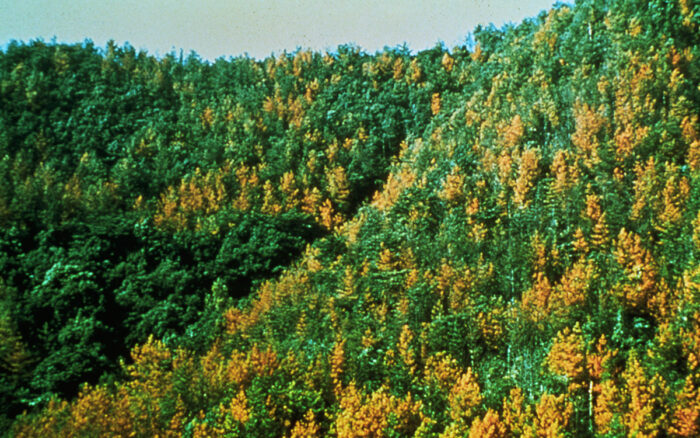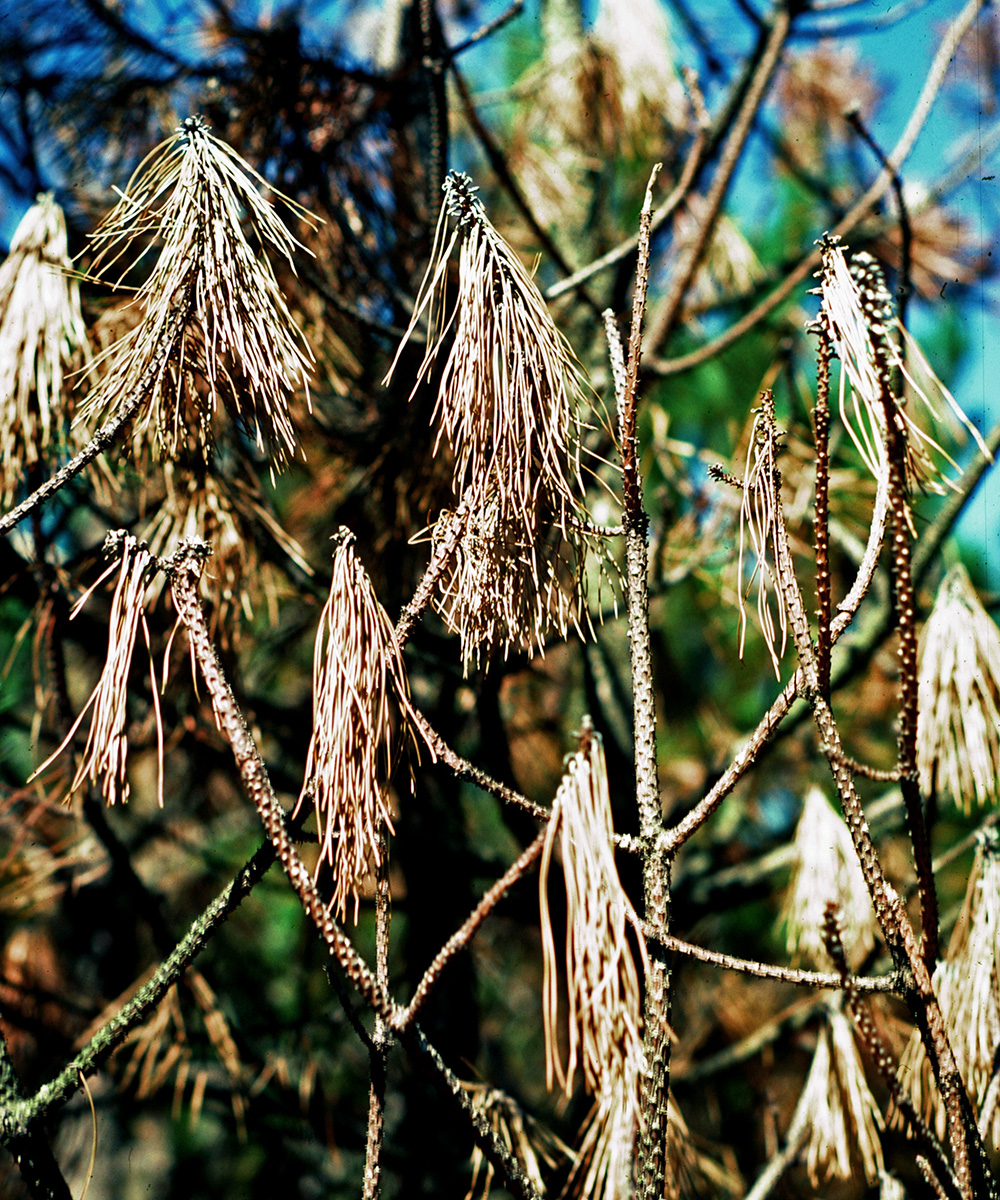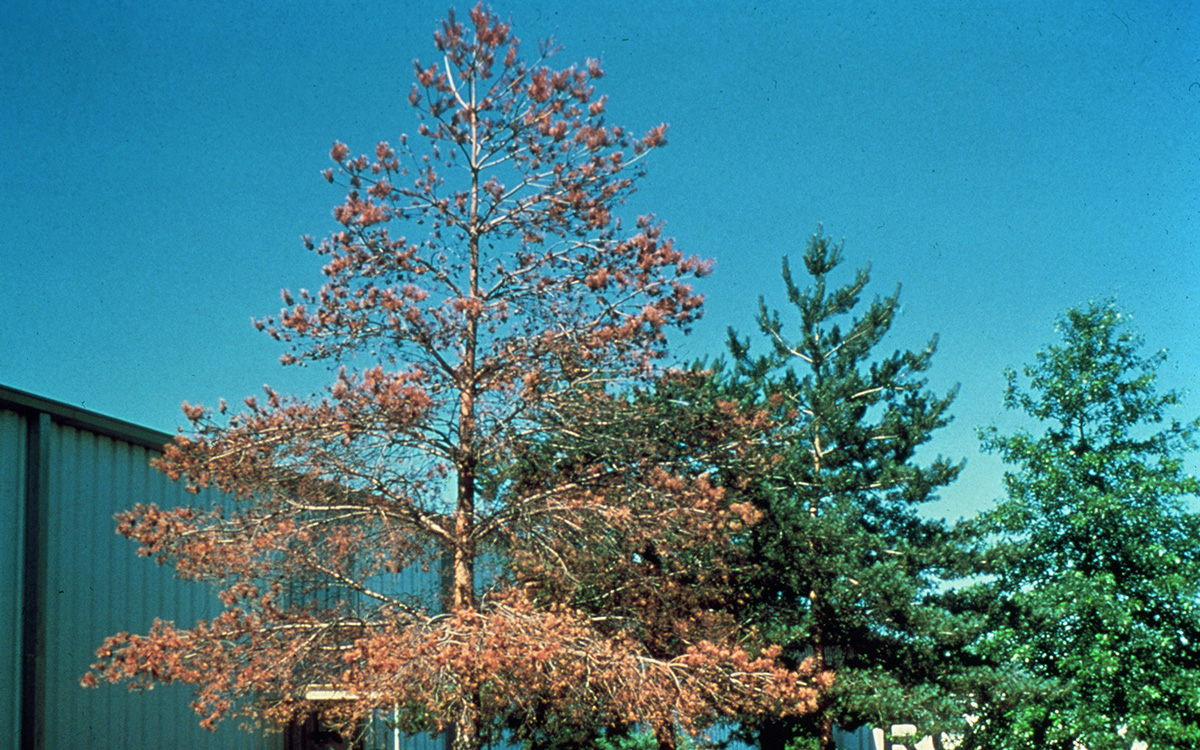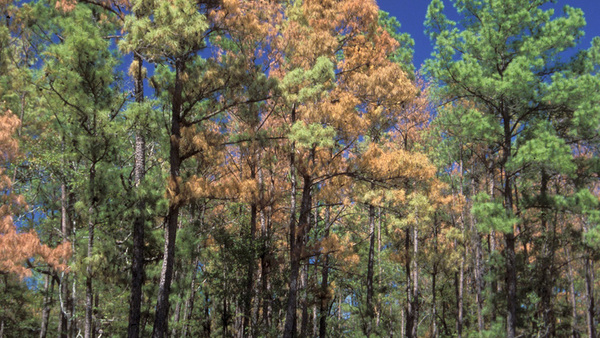
There are several pests that attack pine trees (Pinus spp. and cvs., Zones 2–9) in the Southern Plains—from pine needle scale to needle blight to yellow-bellied sapsuckers—but none are as devastating as pine wilt disease. This dramatic disease kills pine trees very quickly, within a few weeks to a few months. Unfortunately, once a tree is infected, there’s no saving it. However, there are several preventive measures homeowners can take to avoid this disease.
Pine wilt disease at a glance
Pine wilt disease is caused by the pine wood nematode (Bursaphelenchus xylophilus), a microscopic, unsegmented worm that feeds inside the aboveground portions of pine trees. Nematode feeding disrupts the flow of water through the tree, causing wilting symptoms followed by rapid death. Pine wood nematodes cannot move from tree to tree without the assistance of a vector. They hitch a ride in the respiratory systems of pine sawyer beetles (Monochamus spp.), which carry the nematodes to healthy trees as they feed.

Recognizing pine wilt disease
Pine wilt disease affects a variety of pine species, though nonnative species tend to be highly susceptible, including Austrian pine (Pinus nigrai, Zones 4–7), Scotch pine (P. sylvestris, Zones 2–7), Japanese black pine (P. thunbergia, Zones 5–8), and Japanese red pine (P. densiflora, Zones 3–7). Infected trees begin to show symptoms in midsummer through early winter, with needles turning dull gray and then brown. Symptoms of pine wilt begin at the top of the tree and progress downward, a trait that helps distinguish it from needle diseases. Another distinguishing feature is the retention of dead needles, which tend to point toward the ground. Wood cut from an infected tree will be noticeably dry, with little to no pitch flow, and may exhibit blue staining.

Plant selection and care
Stressed trees are more susceptible to both insect and disease infestation, so it is important to keep trees well watered, particularly during times of drought. When selecting new trees to plant in the landscape, avoid the highly susceptible species mentioned above, and select species best suited to your local climate. Native pines are generally considered moderately to highly resistant, although infection has been documented in native species. Here are a few native pines that you might consider planting.
Native pines for the Southern Plains: Eastern species
- Loblolly pine (P. taeda, Zones 6–9)
- Short leaf pine (P. echinata, Zones 6–9)
- Slash pine (P. elliottii, Zones 8–10)
Native pines for the Southern Plains: Western species
- Piñon pine (P. edulis, Zones 5–8)
- Ponderosa pine (P. ponderosa, Zones 3–7)
- Limber pine (P. flexilis, Zones 4–7)
Preventive control
While there are two chemicals (abamectin and emamectin benzoate) labeled for prevention of pine wilt, they are generally not considered to be cost-effective for the typical homeowner. Products containing these chemicals must be injected into the trunk by a certified tree care specialist every one to two years. Additionally, these treatments can only be preventive; they are not effective once trees show symptoms or if pine wilt nematodes have already colonized the tree.
Managing the spread
Currently, the most important management strategy is the timely removal and destruction of infected trees to limit the spread of pine wilt disease. If you have a pine tree that died rapidly and you suspect pine wilt disease, send a sample to your state’s plant disease diagnostic lab for identification. (Ask your local county extension office about this service.) Infected trees should be cut to ground level and the wood burned, chipped, or buried to destroy the nematodes and the pine sawyer beetles. It is important to burn all the wood before the following spring when the beetle vectors emerge. If replanting in the same area, select a deciduous tree species.
Keep an eye on the weather
Pine wood nematode development is dependent on high summer temperatures, making the Southern Plains an ideal environment for this disease. Occurrence of pine wilt disease is expected to increase if warming climate trends continue. Outbreaks associated with wet spring weather have also been noted. With control options limited, making wise tree selection choices now can help limit problems in the future.
—Kim Toscano is a horticulturalist, entomologist, garden designer, writer, and graphic designer. She previously hosted Oklahoma Gardening, a weekly PBS television program produced by the Oklahoma Cooperative Extension Service.
Photos: courtesy of USDA Forest Service—North Carolina Research Station, USDA Forest Service, Bugwood.org
Fine Gardening Recommended Products

Chapin International 10509 Upside-Down Trigger Sprayer
Fine Gardening receives a commission for items purchased through links on this site, including Amazon Associates and other affiliate advertising programs.

ARS Telescoping Long Reach Pruner
Fine Gardening receives a commission for items purchased through links on this site, including Amazon Associates and other affiliate advertising programs.

SHOWA Atlas 370B Nitrile Palm Coating Gloves, Black, Medium (Pack of 12 Pairs)
Fine Gardening receives a commission for items purchased through links on this site, including Amazon Associates and other affiliate advertising programs.



















Comments
Log in or create an account to post a comment.
Sign up Log in